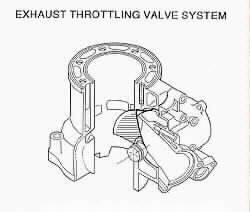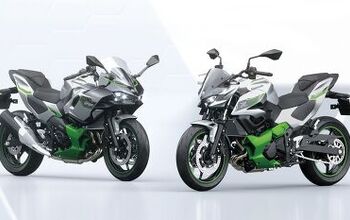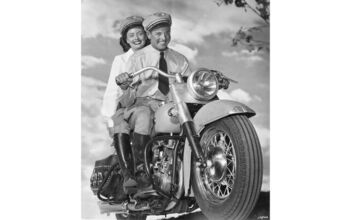Quick Take: Honda EXP-2 - Motorcycle.com
Opening up the throttle on the Baja-winning EXP-2, I aimed the bike down a desert trail at the dust storm following test rider and former Baja winner Bruce Ogilvie. As the EXP-2 blasted off down the trail, its engine note changed from a two-stroke burble to the clattering of pre-ignition. Ignoring the warning of impending doom I opened the throttle wider and hung on. Every other two stroke in the world would have seized solid, right then. But the EXP-2 pulled away without protest.
What's different about the EXP-2 is the weird, muted note to the exhaust -- like a watercraft -- and the clattering noise of pre-ignition (commonly referred to as knocking or pinging) at low- to medium-throttle openings and engine RPM.
Honda has tamed pre-ignition; on the EXP-2 this auto-ignition is computer controlled to enhance performance and most importantly virtually eliminate pollution. Usually thought of as a bastion of four-stroke technology, Honda's new two-stroke design promises less pollution, better fuel economy and most important, no loss in power.
Pre-ignition will destroy a normal two stroke. It is caused when the temperature and pressure in a cylinder builds to a critical point and the air/fuel mixture ignites prematurely in a violent explosion rather than in a controlled burn.
The premature explosions are ignited either by red-hot engine parts or highly ionized reactive molecules left from the last exhaust cycle. Using premature combustion to more thoroughly burn the mixture is not a new idea -- diesels don't have spark plugs either. But it's the first time that auto-ignition has been successfully applied to a gasoline two-stroke. Above idle, and below 40 percent throttle, the spark plug is not used. The exhaust power valve automatically regulates combustion pressure, guaranteeing that pre-ignition will start and end at the correct time. Once the critical pressure is reached, the reactive molecules act like millions of tiny spark plugs, firing the mixture much more evenly than any single plug could.
'Honda claims that when the ARC is engaged, carbon monoxide and carbon dioxide emissions are 15 percent lower, hydrocarbons are down 80 percent, and Nitrous Oxide emissions are down 90 percent...'
Before the emergence of microprocessors, engine management systems were not precise enough to control combustion pressure at all engine speeds. However, with a computer controlled exhaust valve (shown below), pressure in the combustion chamber can be precisely controlled, so pre-ignition can be timed as precisely as an ignition spark. The engine control unit relies on throttle position and engine speed sensors, and uses a knock sensor to detect low-octane fuel. The EXP-2 uses two electronic fuel injectors (shown at right) but engineers at Honda say carburetors would work just as well.
Honda claims that when the ARC (Activated Radical Combustion) is engaged (from idle to about half-throttle) carbon monoxide and carbon dioxide emissions are 15 percent lower, hydrocarbons are down 80 percent and Nitrous Oxide emissions are down 90 percent compared to conventional engines. At idle and at high throttle openings, ignition is by spark plug and emissions are similar to other two strokes.
Why did Honda bother? In case you haven't heard, there are restrictive exhaust emissions laws coming down on motorcycles in many countries. Due to their greater emissions two-stroke have been especially hard-hit. Two-strokes are no longer legal for road use in the US and some countries in Europe may ban them. In California two-strokes will soon be illegal for off-road use except on 'closed courses'. A sad story-until Honda came along offering new hope with a radical new design.
Not content to merely run the new EXP-2 (for experimental two-stroke) engines on the dyno, Honda built a couple of trick off-road rally bikes and entered them in three grueling rallies to race against the best riders in the world, most riding bigger, faster machines. After fourteen days of African desert racing in the Paris-Granada rally (previously the Paris Dakar) J. Brucy's EXP-2 finished 5th overall and first in the under-500cc class. In the punishing week-long Nevada rally, Bruce Ogilvie finished 8th overall, and in the Baja 1000 Honda's riding team of Chuck Miller, Paul Ostbo and Greg Bringle finished 7th overall and first in class.
"We packed up our riding gear and met Honda at a secret location in the Mojave desert to test the EXP-2."
After the EXP-2 proved it could stand up to this kind of destructive treatment, Honda let Motorcycle Online ride it. We packed up our riding gear and met Honda at a secret location in the Mojave desert to test the EXP-2.
Some differences are obvious, like the the main frame, hand-built from aluminum tube and sheet. Other parts are more familiar. The rear sub-frame is sourced from a CR500, as are the seat and fender. The swing-arm is the same size as a CR500 item and is suspended by a Showa shock. The forks are conventional (right-side up) Showa items. A small fairing bolts to a bracket attached to the frame headstock, and can be replaced with a set of headlights for night riding.
Flip the ignition switch hidden in the radiator shroud and the powervalve motor whines as it cycles the valve to the starting position and the fuel pump charges the fuel injection system. The bike kicks over easily for a 400cc single and fires right up. The motor has a mildly-tuned low-end, and top-end similar to an open-class MX bike. In between there's no sudden hit to the powerband, just more power when the rider twists the throttle. The desert gearing is tall, but the friendly powerband makes the bike controllable and fun to ride. That makes life easier for rally riders doing 8 or 10-hour stints in the saddle. We followed Bruce Ogilvie around the desert for a while. Bruce, a former Baja 1000 winner and really fast guy was polite enough to wait at each intersection for us to catch up.
'For an experimental bike, it's very well behaved. The EXP engine has an effective counterbalancer, so the rider doesn't feel any more vibration than a 125 would produce.'
The EXP's suspension has a fairly stiff initial travel, necessary for a desert bike to keep the bike riding high on its suspension so there's room to absorb hard hits. At the speed we were riding we couldn't bottom the suspension. The bike is pretty stable but turns well for a 280-pound desert bike. The broad powerband helps by making it easy to get the rear end to slide just the right amount to carve the turn.
For an experimental bike, it's very well behaved. The EXP engine has an effective counterbalancer, so the rider doesn't feel any more vibration than a 125 would produce. This is important for rally riding- reducing the rider's fatigue lets him ride faster for longer. The 6-gallon fuel tank is narrow at the back compared to the Paris-Granada version's huge tank so the rider can move forward to weight the front end.
We tried to get the bike to detonate unintentionally by lugging it in a sand wash, but it didn't misbehave in any way. Other than the odd engine noise it's easy to forget that the bike is fuel injected and makes less pollution than a weed-wacker. After a morning of riding there wasn't any more residue in the tailpipe than a four-stroke would produce. Even the inside of the silencer stayed clean, an impressive vindication of the low emission design.
Honda plan to campaign the EXP-2 again next year. The company says it has no plans to make a production engine right away, but from the success so far, we'd predict that the world's cleanest two stroke motorcycle will be in production before the year 2000.
More by Eric Murray, Technical Editor






























Comments
Join the conversation